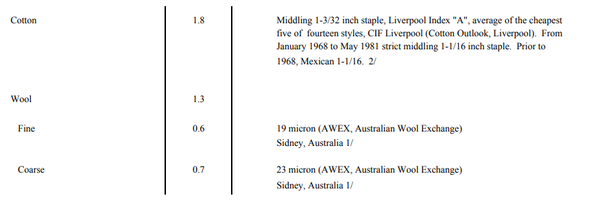Which ports are textiles traded?
By Alfonso Llanes on 07/23/2018 13:49
The end use markets determines the port of departure or entry for all textiles whether natural or technical fibers. Non‐woven are classified as disposable or durables technical textiles, industrial textiles specialty fabrics, garment fabrics medical textiles and soybean blended yarns.
A report from WTO indicates that global trade of textiles and the apparel industry have since the 1950s been subjected to various forms of trade policy measures. Among these are tariffs and non-tariff barriers (NTB)/policy terms of trade. Traders need to understand the dynamics of relevant policy indicators for either technical or natural fibers or textiles and the implications they mean for trade markets and agribusiness investment decisions.
Textile Industry Supply Chain
Cotton Growers, Ginners, Warehousing, and Cotton Shipping
Manmade Fiber Producers
Yarn Spinners and Extruders
Knitters and Weavers
Dyeing and Finishing
Fabric, Apparel, and Furniture Designers
Cutting and Sewing
Shipping
Banking and Insurance
Machinery, Parts, and Service
Chemicals
Water and Energy Providers
Retail and Merchandizing
Products and Markets Trend
Energy
Polyester chain
Nylon chain
Acrylic chain
Viscose chain Cotton chain
Wool
100% Cotton Spun Yarn
100% Polyester spun Yarn
100% Viscose Spun Yarn
Polyester / Viscose Blended Yarn
Polyester / Cotton Blended Yarn
IMF Market Pricing Sample Specifications and Location of Exchanges with Terms of Trade

Sample of Polyester Chain Markets

As one can see ports of origin and discharge had nothing to do with the locations of exchanges and points of trade.
The United States is a very large textile market of both natural and technical fibers. In 2016 the market reported 227,000 U.S. jobs with a value as follows:
$30.3 billion for yarns and fabrics
$24.0 billion for home furnishings, carpet, and other non-apparel sewn products
$12.7 billion for apparel
An estimated $7.4 billion for man-made fibers
113,900 jobs in yarns and fabrics
115,000 jobs in home furnishings, carpet, and other non-apparel sewn products
131,300 jobs in apparel manufacturing
25,700 jobs in man-made fibers
126,600 jobs in cotton farming and related industry
52,500 jobs in wool growing and related industry
However, when these employment figures are examined it is important to note that heavy job losses occurred because of massive import surges in the 1995–2008 periods. Today, like most other U.S. manufacturing sectors, fluctuations in employment figures are generally due to normal business cycles, new investment, or productivity changes.
ITA reports that U.S. exports of fiber, yarns, fabrics, made-ups, and apparel were $26.3 billion in 2016. Shipments to NAFTA and CAFTA-DR countries accounted for 56 percent of all U.S. textile supply chain exports.
The breakdown of exports by sector is as follows:
$4.0 billion — cotton and wool
$4.5 billion — yarns
$8.6 billion — fabrics
$3.6 billion — home furnishings, carpet, and other non-apparel sewn products
$5.6 billion — apparel
In virtually every developing nation, the textile/apparel industry has been the means for economic development, relying on textile and apparel exports for trade revenue. As a consequence, penetrating competition grew, as more countries produced textile and apparel goods for the same markets. In both the United States and Western Europe, the combined textile/apparel/fiber industries were the top manufacturing employers and vital contributors to the economy
Trade-Policy Issues
Pressure from the United States and Europe, resulted in the emergence of multilateral system that provided the protection the industry sought. It follows that trade policies for textiles and apparel from the early 1960s on were no longer subject to the general rules of GATT that governed trade for all other sectors. Textile/apparel trade had its own set of rules that violated many of the basic principles of GATT by allowing restrictions on textile and apparel imports and by permitting discrimination among trading partners.
The New Era Accords
Developing nations had long protested barriers to their textile and apparel goods but finally succeeded in bringing an end to the quota system. As part of the GATT-sponsored Uruguay Round of trade talks, GATT became the World Trade Organization (WTO), and the MFA was replaced by the Agreement on Textiles and Clothing (ATC).
Finally, consumers reap benefits from the intensity of global competition that provides a variety of products at competitive prices for textile and apparel goods.